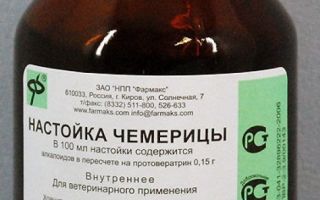Content
Hellebore tincture for cattle is one of the folk remedies that can enhance intestinal peristalsis in ruminants. But this is a poisonous plant, so when using it, you must strictly follow the dosage and precautions.
Composition and action of hellebore tincture
Chemeritsa belongs to the Liliaceae family, all of which are poisonous. Some plants have mild toxic properties, others are deadly. Chemeritsa, she is a puppeteer, belongs to the second group. Its roots are especially poisonous.
The chemical composition of hellebore contains more than 50 different alkaloids that affect the nervous system. The most dangerous is protoveratin, which suppresses the work of the central nervous system and negatively affects the heart and blood vessels. It is because of this alkaloid that the poisoning of cattle with hellebore often leads to the death of animals.
But there are no poisons and drugs, but there is a dose. Therefore, hellebore tincture is often used in veterinary medicine to restore the gastrointestinal tract in ruminants, to destroy ectoparasites and as an emetic for poisoning pigs and dogs. When using the drug, it is necessary to strictly observe the dosage, since an excess will have the opposite effect: the animal will die.
Hellebore preparations, dry rhizomes or tincture, irritate the gastric mucosa, increasing its motility in cattle. In dogs and pigs, this exposure induces vomiting.
Hellebore tincture administered intravenously to a cow for 5-10 minutes restores the motility of the proventriculus and induces chewing. But in case of an overdose, strong excitement occurs, followed by the death of the animal. With injections, it is impossible to take measures against poisoning, everything happens too quickly. Therefore, for cattle, the administration of hellebore preparations subcutaneously and intravenously should be done by an experienced veterinarian.
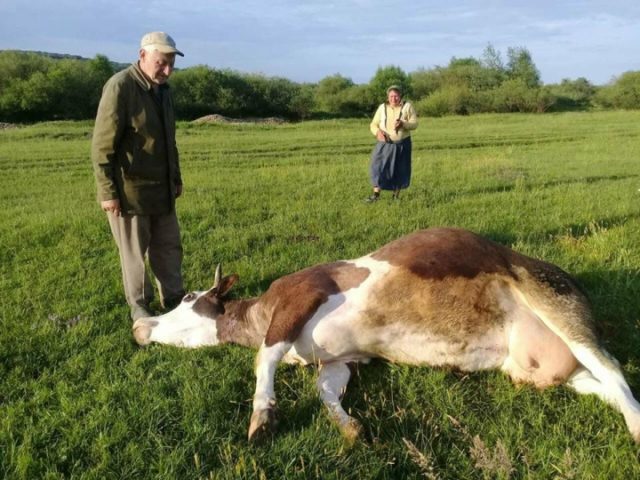
Indications for use for animals
Most often, hellebore tincture is used to treat cattle. It is used by:
- to restore belching in ruminants;
- treatment of atony of the proventriculus;
- when tympanic in cattle;
- with increased motility and secretion of the proventriculus.
When grazing on pasture, animal hair is treated with tincture to protect it from tick attack. Helps selectively.
Hellebore products are used to destroy small ectoparasites on farm animals and pets. Dry rhizome powder is often used against fleas on dogs. But tincture is also suitable. Care must be taken to ensure that the animal does not lick the product from the coat.
As an emetic tincture of hellebore is given only to dogs and pigs. Cattle, small cattle and horses are not physiologically adapted to vomiting, and cats are too small to accurately calculate the dose.For the same reason, the drug should not be given to small breeds of dogs.
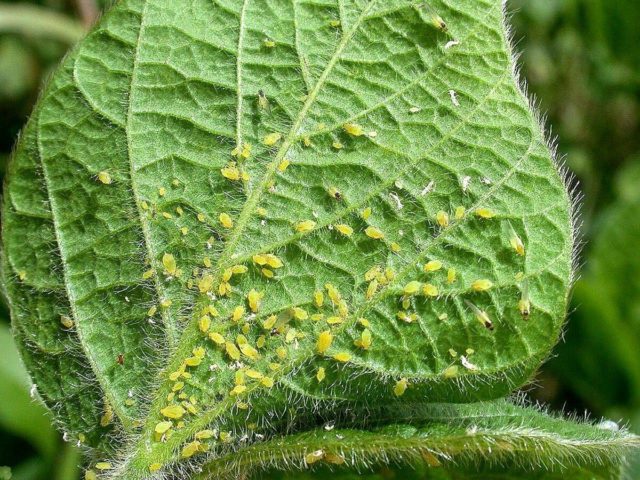
Instructions for the use of hellebore tincture for animals
In the instructions for the use of hellebore in veterinary medicine, the dosage is usually indicated in milliliters per animal. Since the weight of cattle varies from 200 to 1000 kg, only an experienced veterinarian can determine the dose for a specific individual. This is the danger of using the tincture. Better to use another method: ml / kg. But this will require a balance or knowledge of the formula.
The general principle when giving alcoholic tinctures to animals is to breed them 2-3 times. Depending on the strength of the original preparation.
How to dilute and give hellebore tincture for a cow
Often the dose of hellebore tincture for cattle is indicated in milliliters: 5-12 ml. But it is better to calculate the required amount individually for each animal, taking into account its weight. The dosage of hellebore tincture for an adult cow is 0.01-0.024 ml / kg. The difference in two times, how much to enter, the veterinarian decides.
All tinctures are made on the basis of 70% alcohol. This liquid is too strong for animals. When administered orally, the drug is diluted at least three times. More is better. The easiest way is to add the required dose to a glass of water. The mixture is then poured into the animal from a bottle or syringe. The tincture is given for five days once a day.
You can buy a remedy called "hellebore water" in pharmacies. This is already a half-diluted alcoholic infusion.
When administered intravenously, hellebore tincture is diluted in sterile saline. Otherwise, the principle is the same as for oral use.
Single intravenous administration. It is necessary to enter slowly, following the reaction of the animal. In case of overdose, severe agitation and death are possible.
How many drops of hellebore tincture should be given to a calf
The dosage of hellebore for adult cattle is divided by two. Or give at the lower limit, that is, 0.01 ml / kg of body weight. Otherwise, the rules for using hellebore tincture for calves and adult cattle are no different.
How to give hellebore to a goat
Goats are more resistant to alkaloids. Compared to cattle, the dose for them is four times higher. Goats are given 0.04-0.08 ml / kg or 2-4 ml per animal. But the breeds are different. There are dwarfs with a maximum weight of goats up to 40 kg, and there are very large ones, over 100 kg. Therefore, it is better to calculate the dose by weight.
Undiluted tincture of hellebore should not be given to goats, although they seem to be "omnivorous" animals capable of even eating cigarettes. The product is diluted in the same proportions as for cattle.
How to breed a hellebore for a sheep
In keeping and feeding, sheep and goats are practically the same. But the former are on average almost twice as heavy as the latter. The instruction for the drug does not take this into account. The specified 2-4 ml of hellebore tincture for one ram may not be enough. Here it is better to focus on weight, that is, 0.04-0.08 ml / kg. The product is bred in the same way as for goats.
Application for pigs
For pigs, hellebore tincture is an emetic. The dosage in the instructions is usually indicated as 1-2 ml per animal. But even here there is a very large variation in weight. Especially considering the popularity of minipigs as pets. The dosage will be more accurate if you focus on weight: 0.014-0.028 ml / kg. The tincture is diluted to a strength of six degrees or less.
As an emetic drug given once. To restore the work of the gastrointestinal tract, they are soldered in a course once a day until signs of normal peristalsis appear.
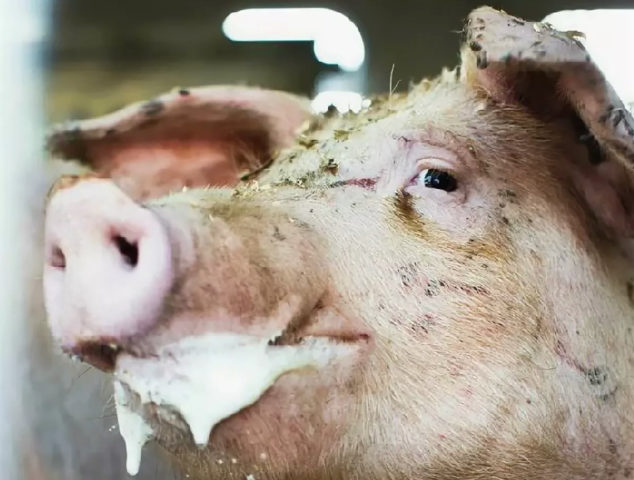
Application for dogs
Dogs are also given hellebore tincture as an emetic. The dosage in this case is 0.05-0.2 ml / kg of animal weight. Single use.
Much more often, hellebore tincture is used to remove fleas from the dog. An undiluted compound will be required. They soak the animal's fur, making sure to treat the skin with liquid. It is more convenient to carry out the procedure with a sponge.
After processing, wait until the dog's coat is completely dry. However, the effectiveness of the tincture is very low. On the first walk, the animal will pick up fleas again. Or those parasites that were on the floor during processing will jump on the dog.
Contraindications
If you do not take into account the likelihood of poisoning with tincture in case of an overdose, then there is only one contraindication: increased individual sensitivity to hellebore. Under the conditions, side effects are usually not observed. In case of overdose and drug poisoning, the animal is injected with a solution of atropine sulfate 1%. The required amount and route of administration are indicated in the instructions for the medication.
How to make a tincture at home
There are two terms for collecting hellebore roots: spring and autumn. After wintering, the roots are most poisonous. During this time, they are mainly harvested to make a powder. Dried rhizomes are used for decoctions that treat plants from pests.
In autumn, raw materials are often collected for the preparation of alcoholic tinctures. However, in terms of toxicity, spring and autumn roots practically do not differ. During the growing season, they have just accumulated enough substances to overwinter and germinate in spring. And after winter they begin to come to life with almost the same supply of nutrients.
The collected roots are washed from the ground and dried in the shade. Then cut into pieces 5-7 cm long or smaller. The raw materials are put into a container, tamped and poured with alcohol or vodka so that the liquid completely covers the roots. They insist for two weeks. The finished preparation is filtered, hermetically closed and removed to a dry, dark place.
For intravenous infusions, you need a product made under aseptic conditions and with strict adherence to the concentration of toxic substances. It is impossible to provide the required dosage at home. The hellebore is more or less poisonous depending on the growing conditions. In some regions, it is even harvested for the winter to feed livestock.
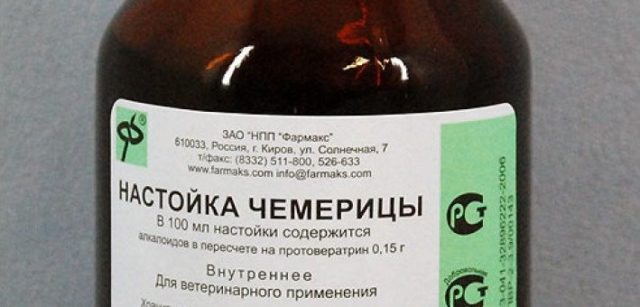
Precautions when making tincture
When collecting raw materials and its further preparation, gloves and a mask must be used. Glasses are desirable. When pollen or small particles of hellebore enter the nose, bleeding occurs. Poisoning is possible when the juice penetrates through the oral mucosa. If hellebore gets into the eyes during work, it will cause irritation. After hands wash thoroughly.
Conclusion
Hellebore tincture for cattle can be useful in the absence of drugs specially designed to combat gastrointestinal problems. But it is better to use it as an external remedy against parasites. There will be no risk of poisoning the animal.


